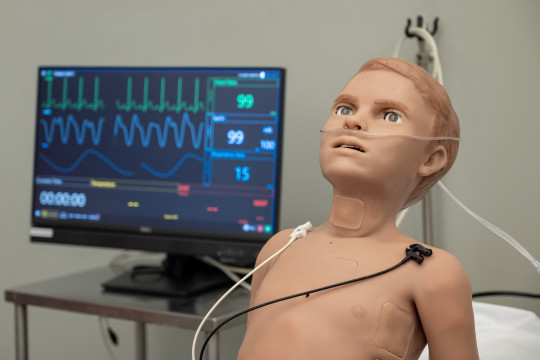Simulation is crucial in the health care environment. Continuous learning, and deliberate practice with simulation allows health care professionals to enhance their skills and stay proficient in a controlled environment. They can practice high-risk, low occurrence events, as well as effective team functioning and collaboration.
“Simulation allows health care providers to reflect on their practice and seek opportunities for improvement, ensuring they can always provide safe and effective care,” says Ashley Thebault, simulation consultant.
IWK Health is part of Nova Scotia’s SimEd Collaborative, a network of organizations throughout the province with a mandate to champion simulation-based learning, consolidate expertise and enable practice sharing. IWK Health, together with Nova Scotia Health, Dalhousie University Faculty of Medicine, Dalhousie University Faculty of Health and Nova Scotia Community College, is celebrating Health Care Simulation Week from November 13–19.
Recently, IWK Health procured what is being referred to as the world’s most advanced pediatric patient simulator: Pediatric HAL, by Gaumard. One of HAL’s greatest attributes is the ability for learners to complete a truly comprehensive pediatric assessment. HAL is interactive and has the ability to illustrate over a dozen facial expressions and emotional states such as angry and scared. It can track objects and people in the room, and can mimic a patient in discomfort or pain by producing real tears. A facilitator can be the voice for Hal and respond to learners in real time while HAL’s jaw moves along with the speech in English or French. HAL’s The pupils can also be programmed to react quickly or slowly, can change in size through a scenario, making a neurological exam much more realistic.
“Because HAL can provide such a detailed assessment, it allows learners to practice patient care in a simulated clinical setting without risk to patients. It can sense a broad range of real patient monitors and sensors. This allows learners to practice setting up with equipment just as they would in real time,” says Thebault. “As an example, pediatric HAL has the ability to support real mechanical ventilation with programmable variables such as dynamic lung compliance, resisting the ventilator, spontaneous breathing, and inspiratory effort. Options like this are incredibly valuable for our Critical Care Team and Life Flight team for instance.”
